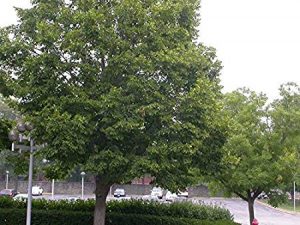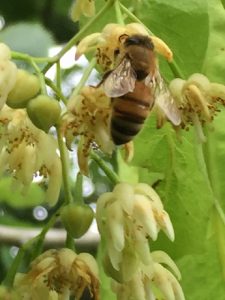While we are not currently selling trees, we have compiled a list of trees and bushes that are an excellent food
source for pollinators.
Alder, Speckled (Alnus rugosa)
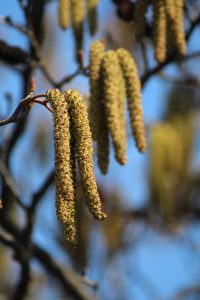
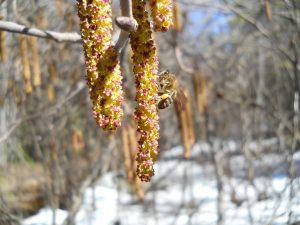
Description
Common Name: hazel alder
Type: Tree
Family: Betulaceae
Native Range: Canada, northeastern United States
Zone: 2 to 6
Height: 15.00 to 25.00 feet
Spread: 15.00 to 25.00 feet
Bloom Time: March
Bloom Description: Purplish-brown (male) and green (female)
Sun: Full sun to part shade
Water: Medium to wet
Maintenance: Low
Flower: Insignificant
Attracts: Birds
Tolerate: Erosion, Wet Soil
Linden - American Basswood (Tilia americana)
Description
The queen of honey plants. Produces large quantities of water-white honey
with aminty flavor. Bee populations are peaking when this tree flowers,
creating the opportunity for major honey crops. The flowers hang down,
preventing dilution of the nectar after summer rains. Produces a crop
3 of 5 years.
Flower Color: White
Zones: 3-8
Growth Habit: Tree
Height: 60-80′
Spread: 40-60′
Light Needs: Sun, part shade
Flowering Season: Late June, Early July
Landscape Value: 3 of 5
Naturalizing Value: 5 of 5
Pollen Value: 3 of 5
Nectar Value: 5 of 5
Water Requirements: medium
Native: Yes
Invasive: No
Linden - European Little Leaf (Tilia cordata)
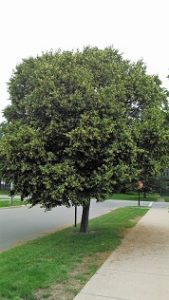
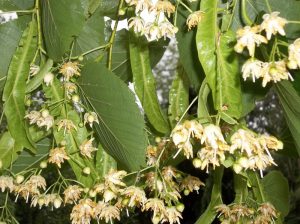
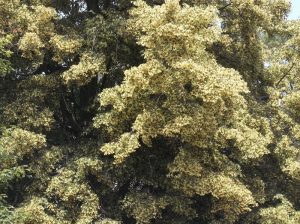
Description
A European linden that makes an excellent landscape, street, and park tree.
Dependable honey and nectar source, producing water-white honey of the highest quality.
A more dependable bloomer than it’s cousin, the American Basswood, but not as large .
Often pruned into hedges in Europe.
Flower Color: White
Zones: 3-7
Growth Habit: Tree
Height: 50-60′
Spread: 30-40′
Light Needs: Full sun to light shade
Flowering Season: Early summer
Landscape Value: 5 of 5
Naturalizing Value: 3 of 5
Pollen Value: 3 of 5
Nectar Value: 5 of 5
Water Requirements: medium
Native: Europe
Invasive: No
Linden - Silver (Tilia tomentosa)
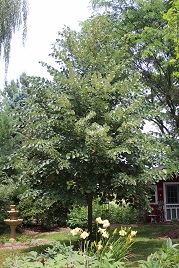
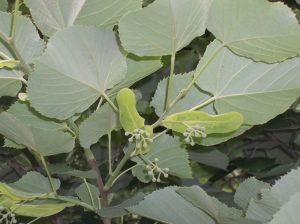
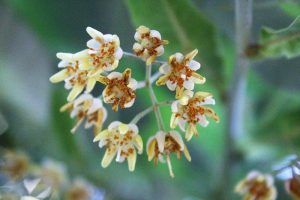
Description
A European variety of what we call basswood. Very popular as a street, ornamental or landscape tree. Blooms at an early age and is very attractive to bees, esp. bumble bees. The leaves are white underneath, giving it a shimmering effect in a breeze. The short hairs on the underside of the leaf make these trees resistant to insect attacks, especially Japanese beetles. The nectar is reported by some as narcotic to bees, but research has not supported this.
Flower Color: Yellowish
Zones: 4 to 7
Growth Habit: Fast
Height: 40 to 50′
Spread: 25 to 30 ‘
Light Needs: Full sun to part shade.
Flowering Season: Late June, Usually just before American basswood (Tilia americana), but sometimes after.
Landscape Value: 5 of 5
Naturalizing Value: n/a
Pollen Value: 3 of 5
Nectar Value: 5 of 5
Water Requirements: Medium. Does well in a high water table.
Native: Europe, Asia
Invasive: No
Sargent Crab Apple
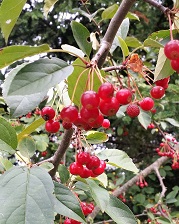


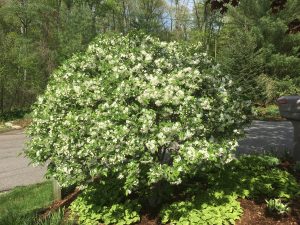
Description
Very disease resistant. The small red fruits remain on trees until Spring,
until they are consumed by Robins and Cedar Waxwings.
As an apple, it is highly attractive to bees. Not grafted, so if the top is damaged or eaten it re-sprouts true to form.
Flower Color: White
Zones: 4-8
Growth Habit: Shrub, small tree
Height: 8′
Spread: 10′
Light Needs: Sun
Flowering Season: Spring
Landscape Value: 5 of 5
Naturalizing Value: 5 of 5
Pollen Value: 3 of 5
Nectar Value: 3 of 5
Water Requirements: Medium
Native: Europe and Asia
Invasive: No
Japanese Pagoda Tree (Sophora japonica)
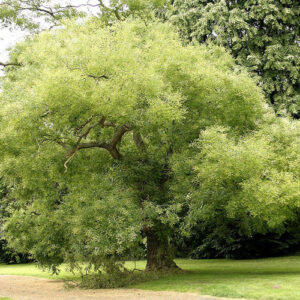
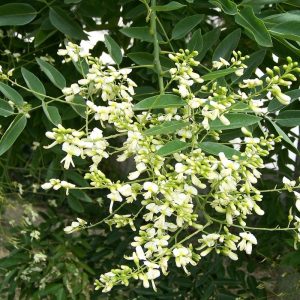
Styphnolobium japonicum Syn. Sophora japonica Schnurbaum Hülsenfrüchtler Schmetterlingsblütler Leguminosae Fabaceae 01
Description
An excellent shade tree for high-stress areas. Lacy foliage
Blooms in August when few trees are in bloom.
Very disease resistant.
Native: Japan
Flower Color: White
Zones: 5-8
Growth Habit: Tree
Height: 20-30′
Spread: 20-30′
Light Needs: Full sun
Flowering Season: Summer
Landscape Value: 4 of 5
Naturalizing Value: n/a
Pollen Value: 4 of 5
Nectar Value: 4 of 5
Water Requirements: low to medium
Oak, White (Quercus alba)

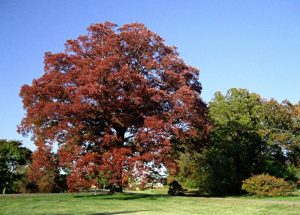
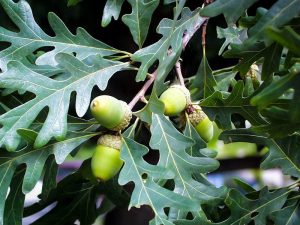

Description
Common Name: white oak
Type: Tree
Family: Fagaceae
Native Range: Eastern United States
Zone: 3 to 9
Height: 50.00 to 80.00 feet
Spread: 50.00 to 80.00 feet
Bloom Time: May
Bloom Description: Yellowish-green
Sun: Full sun
Water: Dry to medium
Maintenance: Medium
Suggested Use: Shade Tree, Street Tree
Flower: Insignificant
Fruit: Showy
Tolerate: Drought, Clay Soil, Dry Soil, Shallow-Rocky Soil, Black Walnu
Catalpa, Northern (Catalpa speciosa)
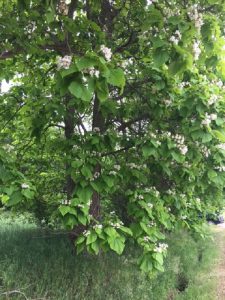
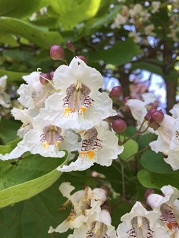
Description
A favorite of bumblebees. Blooms from June into July, depending upon location
and micro-environment. Leaves have nectaries that attract ants and bees prior to bloom.
Said to be an important honey plant in some locations.
Individual florets are some of the most beautiful flowers in Michigan; panicles are 4-8″ long.
Nitrogen-fixing member of the bean family . Large bean pods and large leaves.
Flower Color: White with yellow and purple.
Zones: 4-9
Growth Habit: Tree
Height: 50-60′
Spread: 20-40′
Light Needs: Sun
Flowering Season: Late Spring, Early Summer
Landscape Value: 1 of 5
Naturalizing Value: 4 of 5
Pollen Value: 2 of 5
Nectar Value: 2 of 5
Water Requirements: medium
Native: Yes
Invasive: No
Red Horsechestnut 'Briotii' (Aesculus x carnea)
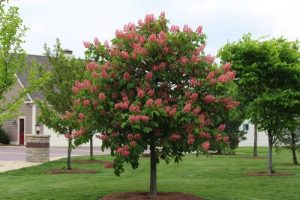
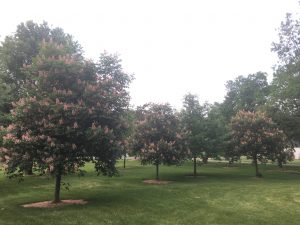

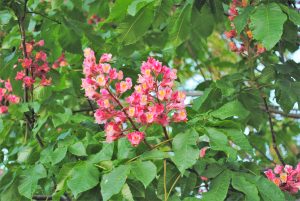
Description
A hybrid of two European varieties, this tree is one of the most popular trees in England. “Ft McNair” was a selection discovered at Ft. McNair, Washington, DC. It has good foliage and outstanding flowers. Readily visited by bees.
Flower Color: Pink with yellow throat on a 6-8″ panicle.
Zones: 4 to 7
Growth Habit: Medium
Height: 25- 35′
Spread: 20-25′
Light Needs: Sun
Flowering Season: Spring
Landscape Value: 5 of 5
Naturalizing Value: n/a
Pollen Value: 2 of 5
Nectar Value: 2 of 5
Water Requirements: Medium
Native: Europe
Invasive: No
Dogwood, Cornelian Cherry (Cornus mas)
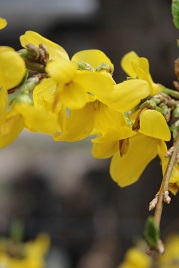
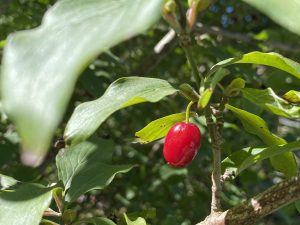
Description
Very hardy dogwood prized for its ornamental bark and fruit. Disease free.
Blooms in March, only a day or two after Silver maple.
Often blooms for several weeks with bright yellow flowers.
Visited by many bee species. A harbinger of spring.
Flower Color: Yellow
Zones: 4-7
Growth Habit: Shrub or small tree
Height: 15-20′
Spread: 12-15′
Light Needs: Sun or part-shade
Flowering Season: Early spring
Landscape Value: 4 of 5
Naturalizing Value: 4 of 5
Pollen Value: 2 of 5
Nectar Value: 2 of 5
Water Requirements: medium
Native: Europe, Asia
Invasive: No
Chinese Chestnut (Castanea mollissimi)
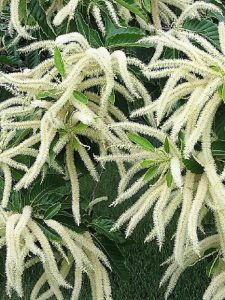

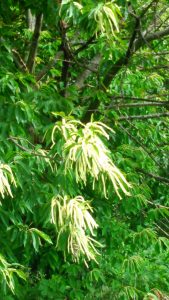
Description
Heavy early Summer bloomer. Used as a substitute for American Chestnut as a nut
and wildlife food. Resistant but not immune to Chestnut blight.
Not for use in a high-traffic area because of the abundant fruit drop, covered with spines and
surrounded by turkeys, deer, and squirrels.
Beautiful yellow fall leaves.
Flower Color: Pale yellow to cream
Zones: 4-8
Growth Habit: Tree
Height: 40-60′
Spread: 40-60′
Light Needs: Sun to part shade
Flowering Season: Late June, early July.
Landscape Value: 1 of 5
Naturalizing Value: 5 of 5
Pollen Value: 2 of 5
Nectar Value: 3 of 5
Water Requirements: medium
Native: Korea, China, introduced 1853
Invasive: No
Cedar - White (American arborvitae)
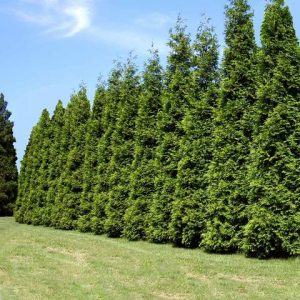

Description
Common Name: American arborvitae
Type: Needled evergreen
Family: Cupressaceae
Native Range: Eastern North America
Zone: 2 to 7
Height: 20.00 to 40.00 feet
Spread: 10.00 to 15.00 feet
Bloom Time: Non-flowering
Bloom Description: Non-flowering
Sun: Full sun to part shade
Water: Medium
Maintenance: Low
Leaf: Evergreen
Other: Winter Interest
Tolerate: Clay Soil, Wet Soil, Black Walnut, Air Pollution
Invasive: no
Maackia (Maackia amurensis)
OLYMPUS DIGITAL CAMERA OLYMPUS DIGITAL CAMERA
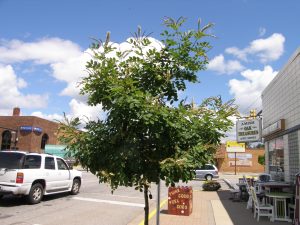
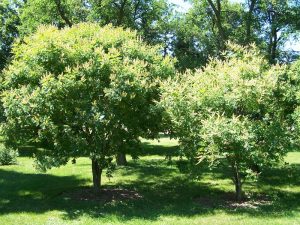
Description
Common Name: maackia
Type: Tree
Family: Fabaceae
Native Range: Russia, eastern Asia
Zone: 3 to 7
Height: 20.00 to 30.00 feet
Spread: 20.00 to 30.00 feet
Bloom Time: June
Bloom Description: Dull White
Sun: Full sun to part shade
Water: Medium
Maintenance: Low
Suggested Use: Shade Tree, Street Tree, Flowering Tree
Flower: Showy, Fragrant
Culture
Best grown in average, medium moisture, well-drained soil in full sun to part shade. Prefers full sun. Adapts to a wide range of soil conditions.
Noteworthy Characteristics
Amur maackia is a small, deciduous tree with a broad, rounded habit. Typically grows in cultivation at a slow-to-moderate rate to a height of 20-30′ (to 60′ in the wild). Features erect, narrow, spike-like clusters (4-6″ long) of fragrant, dull white, pea-like flowers which appear in late spring. Flowers are followed by flat seed pods (2-3″ long). Compound, odd-pinnate, dark olive green leaves (7-13 leaflets each) are attractive in summer but produce no fall color. Coppery-bronze bark exfoliates on mature trees. Karlovich Maack, a 19th century Siberian explorer, discovered the tree growing in the region of the Amur River which serves as the border between Siberia and China. This member of the pea family is both closely related and similar in appearance to the slightly larger yellowwood (Cladrastis). Yellowwood has more attractive flowers and excellent fall color.
Genus name honors Richard Maack [Richard Karlovich Maak](1825-1886), Russian naturalist and explorer.
Specific epithet recognizes the Amur River valley where it was discovered.
Yellowwood - American
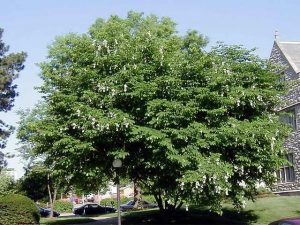
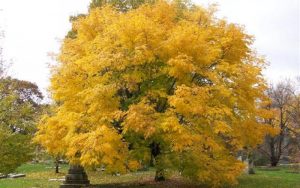
Description
Common Name: yellowwood
Type: Tree
Family: Fabaceae
Native Range: North America
Zone: 4 to 8
Height: 30.00 to 50.00 feet
Spread: 40.00 to 55.00 feet
Bloom Time: May
Bloom Description: White
Sun: Full sun
Water: Medium
Maintenance: Low
Suggested Use: Shade Tree, Flowering Tree
Flower: Showy, Fragrant
Leaf: Good Fall
Culture
Easily grown in average, medium moisture, well-drained soils in full sun. Tolerates some dry soils once established. Best sited in a location protected from strong winds. Prune in summer because cuts made in late winter or spring tend to bleed.
Noteworthy Characteristics
Cladrastis kentukea, commonly called American yellowwood, is a medium-sized, deciduous tree of the legume family that typically grows 30-50’ tall with upright branching and a broad, rounded crown. It is noted for its pinnately compound foliage, panicles of fragrant white spring flowers, autumn seed pods and yellow fall color. The species is native to the southeastern U.S. In Missouri, it typically occurs in several southwestern counties near the White River and its tributaries. Pinnately compound leaves (usually with 7-11 leaflets) open as yellowish green, turn bright green in summer and then turn yellow in fall. Intensely fragrant, wisteria-like, pink flowers in large, drooping, terminal panicles (10-15” long) will cover a mature tree in late spring. Profuse bloom may occur only once every 2 or 3 years however. New trees may not bloom for the first 8-10 years. Bloom is similar in appearance to that of black locust (Robinia). Flowers give way to flat seed pods (2.5-4” long) that mature in September-October. Species was formerly called Cladrastus lutea.
Genus name comes from the Greek klados meaning branch and thraustos meaning fragile for the brittle twigs.
Hazlenut - American
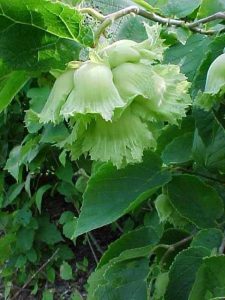
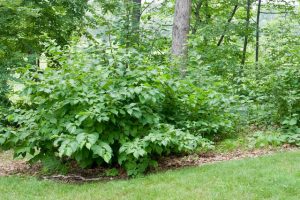
Description
Common Name: American hazelnut
Type: Deciduous shrub
Family: Betulaceae
Native Range: Eastern North America
Zone: 4 to 9
Height: 10.00 to 16.00 feet
Spread: 8.00 to 13.00 feet
Bloom Time: March to April
Bloom Description: Male – brown, female – red
Sun: Full sun to part shade
Water: Medium
Maintenance: Low
Suggested Use: Hedge
Flower: Showy
Leaf: Good Fall
Attracts: Birds
Fruit: Edible
Tolerate: Clay Soil, Black Walnut
Culture
Easily grown in average, medium, well-drained soil in full sun to part shade. Prompt removal of root suckers will help maintain plant appearance, and, if desired, help prevent thicket formation.
Noteworthy Characteristics
Corylus americana, commonly called American filbert or hazelnut, is a Missouri native, deciduous, rounded, multi-stemmed shrub which typically grows 8-16′ tall and occurs statewide in dry or moist thickets, woodlands and wood margins, valleys, uplands and prairies. Monoecious (separate male and female flowers on the same plant). In spring, male flowers appear in showy, 2-3″ long, yellowish brown catkins and female flowers appear in small, reddish, inconspicuous catkins. Female flowers give way to small, egg-shaped, 1/2″ long, edible nuts (maturing July-August) which are encased in leafy, husk-like, ragged-edged bracts. Nuts are similar in flavor to the European filbert, and may be roasted and eaten or ground into flour, but are also commonly left for the squirrels and birds. Ovate, double-toothed, dark green leaves (3-6″ long). Fall color is quite variable, ranging from attractive combinations of orange, rose, purplish red, yellow and green to undistinguished, dull yellowish green.
Sourwood - Oxydendrum arboreum
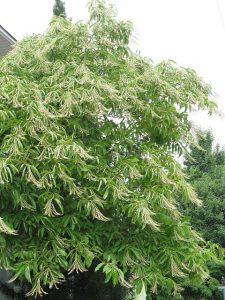
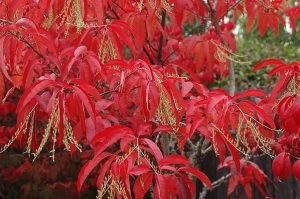
Description
A common tree of the South, known for its fine honey. This tree does well in Michigan;
plant it as an ornamental tree.
Blooms in July in 4-10″ panicles. Often in bloom for 3-4 weeks.
Good fall color.
Flower Color: White
Zones: 5-9
Growth Habit: Tree
Height: 25-30′
Spread: 20′
Light Needs: Sun to shade
Flowering Season: July
Landscape Value: 5 of 5
Naturalizing Value: 3 of 5
Pollen Value: 2 of 5
Nectar Value: 4 of 5
Water Requirements: Well drained, medium water
Native: Yes
Invasive: No
Maple - Mountain (Acer spicatum)

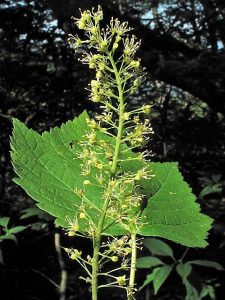
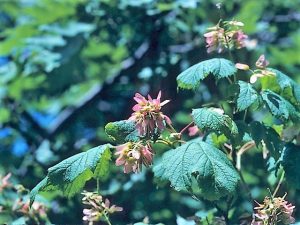
Description
A maple common to North woods and higher elevations of the South; it grows in the shade of other trees. This tree blooms in June, when bees are built up enough to take advantage of the nectar flow, and can be the source of considerable nectar. Surplus honey can be collected from this tree alone.
Flower Color: Greenish-yellow
Zones: 3 to 7 (at higher elevations)
Growth Habit: Slow to medium.
Height: 10 to 30 ‘
Spread: 10 to 30′
Light Needs: Shade
Flowering Season: June
Landscape Value: 1 of 5
Naturalizing Value: 5 of 5
Pollen Value: 2 of 5
Nectar Value: 3 of 5
Water Requirements: Moist
Native: Yes
Invasive: No
Maple - Striped Moosewood (Acer pensylvanicum)
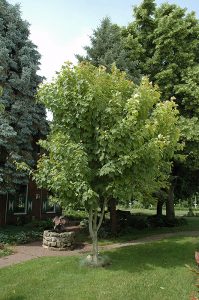
Description
Common Name: snakebark maple
Type: Tree
Family: Sapindaceae
Native Range: Northeastern United States, eastern Canada
Zone: 3 to 7
Height: 15.00 to 25.00 feet
Spread: 12.00 to 20.00 feet
Bloom Time: April to May
Bloom Description: Yellow
Sun: Part shade
Water: Medium
Maintenance: Low
Flower: Showy
Leaf: Good Fall
Other: Winter Interest
Tolerate: Heavy Shade
Culture
Easily grown in average, medium moisture, well-drained soils in part shade. Excellent shade tolerance. Plants dislike full sun conditions. Slightly acidic, consistently moist soils are preferred. Best performance occurs in cool summer climates.
Noteworthy Characteristics
Acer pensylvanicum commonly known as snakebark maple is a shrubby understory maple that is native to moist, rocky forests from Wisconsin to Quebec and south in the Appalachians to Georgia. It typically grows as a large shrub or small tree to 15-25’ tall (less frequently to 40’ tall) with a rounded but uneven crown that is sometimes flat-topped. This is the only species of snakebark maple that is native to North America. Key ornamental features are its interesting bark and fall color. Greenish bark on young branches and young trunks is vertically marked with distinctive white stripes (hence the common names of snakebark maple and striped maple). Stripes may vanish over time as older bark turns reddish brown. Obovate, double-serrulate, three-lobed leaves (to 7” long) emerge with pink hues in spring, mature to dark green by summer and turn bright yellow in fall. Leaf purportedly resembles a goose foot, hence the common name of goosefoot maple for this plant. Small yellow flowers (1/3” diameter) bloom in pendant racemes (to 6” long) in spring (May). Flowers give way to winged samaras (to 1” long). Moose and white tailed deer often browse the leaves and young twigs hence the common name of moosewood. Whistles can easily be carved from branch sections, hence the common name of whistlewood.
Genus name is the Latin name for a maple tree.
Although misspelled by Linnaeus, the specific epithet is in fact a reference to the State of Pennsylvania where this tree is native.
Maple - Sugar (Acer saccharum)
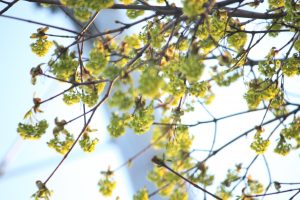
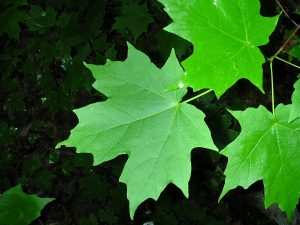
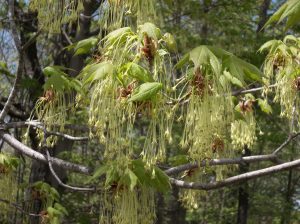
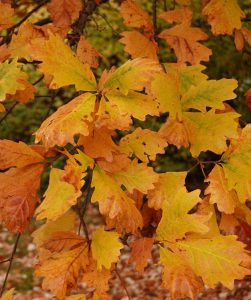

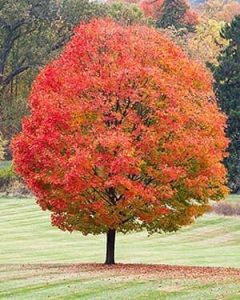
Description
Common Name: sugar maple
Type: Tree
Family: Sapindaceae
Native Range: Eastern North America
Zone: 3 to 8
Height: 40.00 to 80.00 feet
Spread: 30.00 to 60.00 feet
Bloom Time: April
Bloom Description: Greenish
Sun: Full sun to part shade
Water: Medium
Maintenance: Medium
Suggested Use: Shade Tree
Flower: Insignificant
Leaf: Good Fall
Tolerate: Heavy Shade
Culture
Easily grown in average, medium moisture, well-drained soil in full sun to part shade. Best in fertile, slightly acidic, moist soils in full sun. Grows poorly in compacted, poorly drained soils. Intolerant of road salt. Generally intolerant of urban pollution.
Noteworthy Characteristics
Acer saccharum commonly known as sugar maple is a deciduous, Missouri native tree which will typically grow 40′ to 80′ tall (sometimes to 100′) with a dense, rounded crown. This tree is a main component of the Eastern U.S. hardwood forest and is one of the trees which is most responsible for giving New England its reputation for spectacular fall color. Medium green leaves (3-6″ wide with 3-5 lobes) turn yellow-orange in autumn, sometimes with considerable color variations. Fruit is the familiar two-winged samara. Sugar maples are long-lived trees which grow relatively slowly (somewhat faster in the first 35 years). Native Americans taught the early colonists how to tap these trees to make maple syrup which has now become a multi-billion dollar industry in the U.S. and Canada. Excellent shade tree. The sugar maple leaf is the national symbol of Canada.
Genus name is the Latin name for a maple tree.
Specific epithet means sugary in reference to the sweet sap. Saccharum is the genus name for sugarcane.
Maple - Red (Acer rubrum)
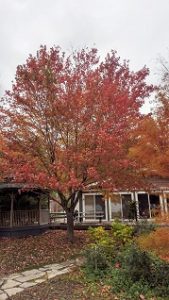
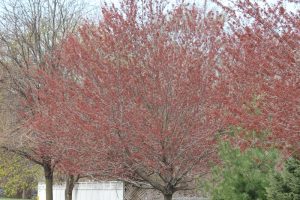
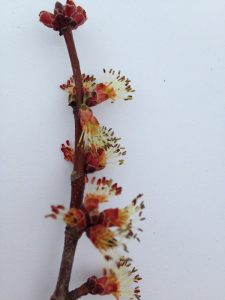
Description
One of the most important early-blooming trees for pollinators. An abundance of blooms, coupled with genetic diversity
and local environments provide a source of nectar and pollen for four to five weeks. Honeybees build colony
populations quickly on this early bloomer, especially in conjunction with willows.
Red maple cultivars are prevalent as landscape trees, but the hybrids are not useful to bees. Red maples have green leaves that turn red in the Fall.
Flower Color: Red
Zones: Zones 3-9
Growth Habit: Tree
Height: 50-70′
Spread: 50-70′
Light Needs: Sun to shade
Flowering Season: Spring
Landscape Value: 5 of 5
Naturalizing Value: 5 of 5
Pollen Value: 4 of 5
Nectar Value: 4 of 5
Water Requirements: Medium
Native: Yes
Invasive: No
Maple - Japanese Acer palmatum, var. Atropurpureum
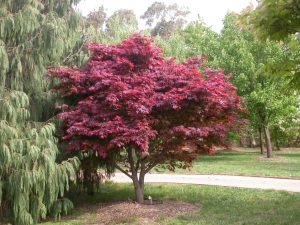
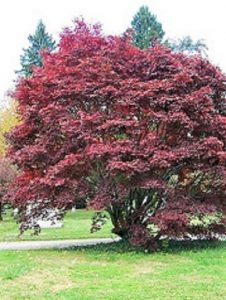
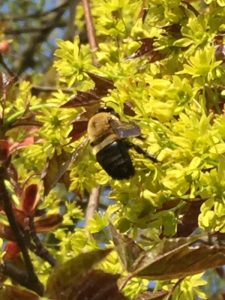
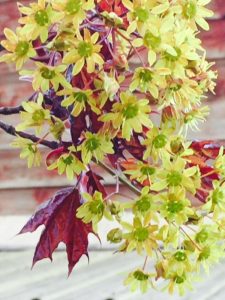
Description
A popular landscape tree offering good maroon spring color that fades to greenish -red.
Flower Color: Small, red to purple in spring, as the leaves emerge.
Zones: 5 to 8
Growth Habit: Medium
Height: 15 to 20′
Spread: 15 to 20′
Light Needs: Full sun to part shade.
Flowering Season: Spring
Landscape Value: 5 of 5
Naturalizing Value: n/a
Pollen Value: 3 of 5
Nectar Value: 3 of 5
Water Requirements: Medium
Native: Japan
Invasive: No
Bottlebrush Buckeye var."Serotina"

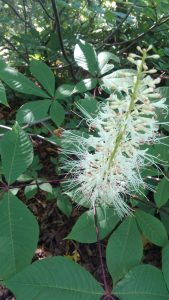
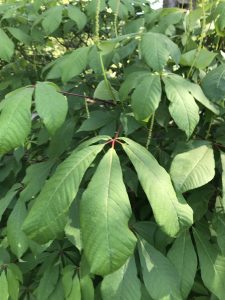
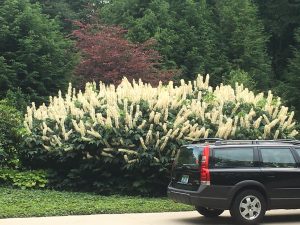
Description
A large shrub that spreads from root suckers, it is usually no more than 10′ tall. The cultivar “Serotina”
has 30″ inflorescences and blooms 2 weeks later than the species.
Few summer flowering shrubs can rival this one, and should be a part of every homeowners’ landscape.
Tolerates deep shade or full sun.
Native: Yes
Flower Color: white
Zones: 4-8
Growth Habit: shrub
Height: 10-15′
Spread: 10-15′
Light Needs: sun to shade
Flowering Season: Summer
Landscape Value 5 of 5
Naturalizing Value: 5 of 5
Pollen Value: 3 of 5
Nectar Value: 2 of 5
Water Requirements: medium
Raspberry - Native
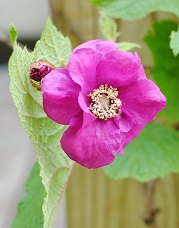
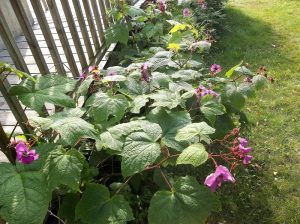
Description
This is a plant grown for it’s flower, not its fruit. The flower is outstanding in June and July
with 1-2″ rich, fragrant, pink-purple flowers.
Attractive to many bees.
Flower Color: Pink-purple
Zones: 5-6
Growth Habit: Shrub
Height: 3-6′
Spread: 3-6′
Light Needs: Sun to light shade
Flowering Season: Summer
Landscape Value: 3 of 5
Naturalizing Value: 4 of 5
Pollen Value: 2 of 5
Nectar Value: 2 of 5
Water Requirements: medium
Native: Yes
Invasive: No
Chokeberry - Black
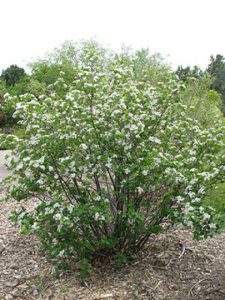

Description
Common Name: black chokeberry
Type: Deciduous shrub
Family: Rosaceae
Native Range: Eastern North America
Zone: 3 to 8
Height: 3.00 to 6.00 feet
Spread: 3.00 to 6.00 feet
Bloom Time: May
Bloom Description: White
Sun: Full sun to part shade
Water: Medium
Maintenance: Low
Suggested Use: Hedge, Naturalize, Rain Garden
Flower: Showy
Leaf: Good Fall
Attracts: Birds
Fruit: Showy, Edible
Tolerate: Wet Soil
Elderberry - Black (American) (Sambucus canadensis)

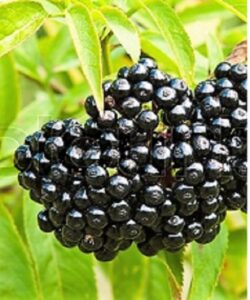
Description
5-7 leaflets comprise each leaf of this water-loving, multi-stem shrub. The black fruit is used for pies, jellies, juice, and wine.
Very attractive to birds. Used medicinally.
Flower Color: White
Zones: 3 to 9
Growth Habit: Fast
Height: 10-15′
Spread: 6 to 8′
Light Needs: Full sun to part-shade
Flowering Season: Late Spring
Landscape Value: 2 of 5 Cultivars with attractive foliage are available in the trade.
Naturalizing Value: 5 of 5 Prefers wet soil, but grows in gardens and orchards if mulched.
Pollen Value: 2 of 5
Nectar Value: 1 of 5
Water Requirements: Medium to high. Tolerates wet feet more than it needs wet feet.
Native: Yes
Invasive: No
Summersweet - Ruby Spice (Clethra alnifolia)
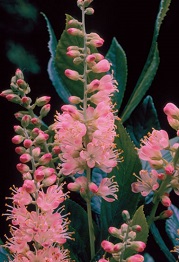
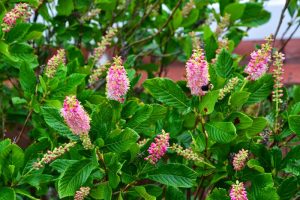
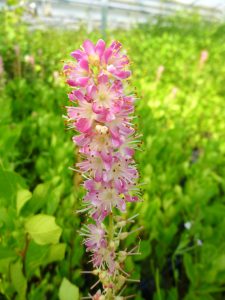
Description
The flowers are attractive to bees and butterflies, and the resulting dark brown seed capsules will attract birds during the autumn.
Blooms 3-5 weeks with fragrant, pink flowers. Blooms mid July to Mid August.
Very Hardy, prefers well-drained, high organic soil, but tolerates wet soil too.
Grows in Sun to shade, prefers dappled shade.
One of the finest compact flowering shrubs. Attractive to many pollinators.
Flower Color: Pink
Zones: 3-9
Growth Habit: Shrub
Height: 5-10′
Spread: 4-6′
Light Needs: Sun-Shade
Flowering Season: Spring-Summer
Landscape Value: 5 of 5
Naturalizing Value: 5 of 5
Pollen Value: 2 of 5
Nectar Value: 3 of 5
Water Requirements: all but drought
Native: species native
Invasive: no
Japanese Tree Lilac (Syringa reticulata)
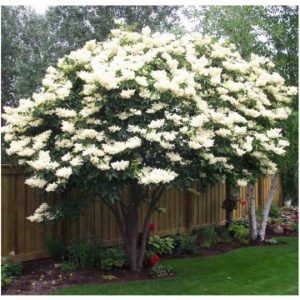
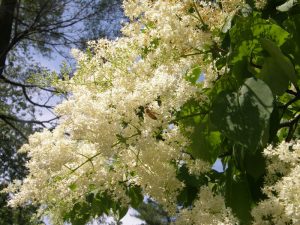
Description
Common Name: Japanese tree lilac
Type: Tree
Family: Oleaceae
Native Range: Northern China
Zone: 3 to 7
Height: 20.00 to 30.00 feet
Spread: 15.00 to 20.00 feet
Bloom Time: June
Bloom Description: Creamy white
Sun: Full sun
Water: Medium
Maintenance: Low
Suggested Use: Hedge, Street Tree, Flowering Tree
Flower: Showy, Fragrant
Attracts: Hummingbirds, Butterflies
Tolerate: Deer, Clay Soil
Culture
Easily grown in average, medium moisture, well-drained soil in full sun. Tolerates light shade, but best bloom occurs in full sun. Prefers organically rich, moist, slightly acidic soils with good drainage. Needs good air circulation. Tolerates urban conditions well. To the extent practicable, faded flower panicles should be removed prior to seed set. Prune as needed immediately after flowering. Best growth typically occurs in cool summer climates. Not recommended for planting south of USDA Zone 7.
Noteworthy Characteristics
Syringa reticulata, commonly called Chinese tree lilac, typically grows as a small tree or large shrub. In tree form, it grows to 30’ tall and 20’ wide with an oval-rounded crown. Its best ornamental feature is its showy, fragrant, creamy white flowers which bloom in upright panicles to 12” long in late spring to early summer (later than most other lilac species). Some gardeners dislike the privet-like smell of the flowers. Flowers give way to loose clusters of brown capsules that persist into winter. Reddish-brown peeling bark is attractive on younger branches, gradually turning gray with age. Sharply-tipped, lanceolate to ovate, dark green leaves (to 6” long). No fall color.
Genus name comes from the Greek word syrinx meaning tube or pipe in reference to the pith-filled but easily-hollowed stems of some genus plants.
Specific epithet means netted-veined in reference to the leaf veins.
Syringa reticulata subsp. reticulata is native to Japan and is sometimes commonly called Japanese tree lilac. Syringa reticulata subsp. pekinensis is native to China and is sometimes commonly called Chinese tree lilac or Peking lilac. Syringa reticulata subsp. amurensis is native to Korea and eastern Russia and is commonly called Amur tree lilac or Amur lilac.
Lilac - Miss Kim (Syringa pubescens subsp. patula 'Miss Kim')
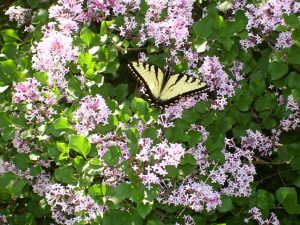


Description
A dwarf lilac that blooms late in the spring. Very Fragrant, and very attractive to butterflies and bees. Disease and deer resistant and low maintenance.
Flower Color: Lavender flowers that cover the entire plant. Zones: 3 to 8
Growth Habit: Medium Height: 4 to 8
Spread: 5 to 7 ‘
Light Needs: Full sun
Flowering Season: Late May
Landscape Value: 5 of 5
Naturalizing Value: n/a
Pollen Value: 1 of 5
Nectar Value: 2 of 5
Water Requirements: Medium
Native: China
Invasive: No
Summersweet - Hummingbird (Clethra alnifolia)

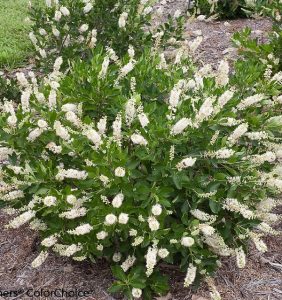
Description
The flowers are attractive to hummingbirds, bees and butterflies, and the resulting dark brown seed capsules will attract birds during the autumn.
Blooms 3-5 weeks with fragrant, white flowers. Blooms mid July to Mid August.
Very Hardy, prefers well-drained, high organic soil, but tolerates wet soil too.
Grows in Sun to shade, prefer dappled shade.
One of the finest compact flowering shrubs. Attractive to many pollinators.
Flower Color: White
Zones: 3-9
Growth Habit: Shrub
Height: 2-4′
Spread: 3-5′
Light Needs: Sun-Shade
Flowering Season: Spring-Summer
Landscape Value: 5 of 5
Naturalizing Value: 5 of 5
Pollen Value: 2 of 5
Nectar Value: 3 of 5
Water Requirements: all but drought
Native: species native
Invasive: no
Lilac - Palibin
Sierra Exif JPEG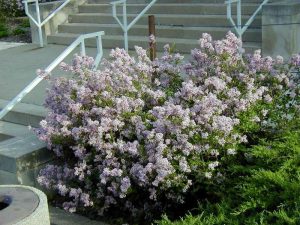
Description
Common Name: lilac
Type: Deciduous shrub
Family: Oleaceae
Zone: 3 to 7
Height: 4.00 to 5.00 feet
Spread: 5.00 to 7.00 feet
Bloom Time: April to May
Bloom Description: Pale pink
Sun: Full sun
Water: Dry to medium
Maintenance: Low
Suggested Use: Hedge
Flower: Showy, Fragrant
Attracts: Hummingbirds, Butterflies
Tolerate: Deer, Drought, Erosion, Dry Soil
Culture
Easily grown in average, dry to medium moisture, well-drained soil in full sun. Tolerates light shade, but best bloom is in full sun. Prefers organically rich, moist, slightly acidic to slightly alkaline soils. Needs good air circulation. Good tolerance for urban conditions. Prompt removal of faded flower panicles before seed set will increase the bloom in the following year. Prune as needed immediately after flowering.
Noteworthy Characteristics
Syringa meyeri, commonly called Meyer lilac or Korean lilac, was found growing in a garden near Beijing, China by Frank Meyer in 1909. It is not known to exist in the wild. It is a compact, rounded, slow-growing, deciduous shrub that matures to 5-8′ tall and spreads to 10′ wide. Pale lilac to violet-purple flowers bloom in small, dense terminal clusters (panicles to 3-4″ long) in late April to early May (St. Louis area). Flowers are fragrant. Small, broad-elliptic to obovate leaves (to 2″ long) are dark green. No fall color.
Genus name comes from the Greek word syrinx meaning tube or pipe in reference to the pith-filled but easily-hollowed stems of some genus plants.
Specific epithet honors Frank Meyer who collected this plant in China in 1909.
‘Palibin’ is a compact, low-spreading cultivar which typically grows 4-5’ tall with a spread of 5-7’. Pale pink, sweetly-fragrant single flowers arranged in dense, terminal clusters (panicles to 4” long) cover this shrub with a profuse bloom. This shrub is sometime grafted to a 4’ standard and sold as a small tree with a dense, rounded crown. Tree form typically matures to 8’ tall.
Butterfly Bush - Miss Molly (Buddleia davidii) A Proven Winners Selection.
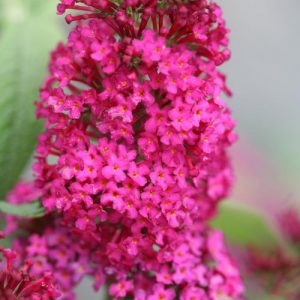
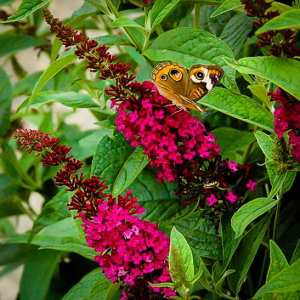


Description
This brilliant, ruby red, deer and drought resistant Butterfly Bush is a must have for butterflies,bees, and other pollinators. Smaller in size than other varieties, Miss Molly is easy to incorporate into any sunny landscape.
Flower Color: Ruby-Red, Pink
Zones: 5-9
Growth Habit: Shrub
Height: 4-5′
Spread: 4-5′
Light Needs: Sun
Flowering Season: Mid-Summer-Late Fall
Landscape Value: 5 of 5
Naturalizing Value: 2 of 5
Pollen Value:
Nectar Value:
Water Requirements: Moderate
Native: China
Invasive: No
Hydrangea - BOBO (Hydrangea paniculata) Proven Winner selection
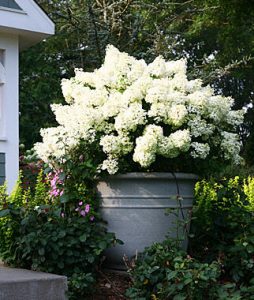
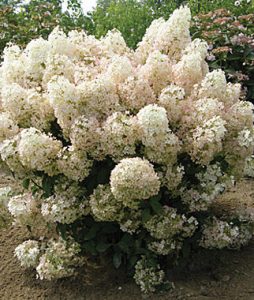
Description
A Proven Winner selection, with prominant summer flowers.
Very attractive to bees, especially bumble bees.
Adaptable to most soils, and flower color is not affected by soil pH.
Grow for cut and dried flowers
Flower Color: Large white flowers that turn pink.
Zones: 3 to 8
Growth Habit: Medium
Height: 4 to 5′
Spread: 4 to 5 ‘
Light Needs: Sun to partial shade
Flowering Season: Summer
Landscape Value: 5 of 5
Naturalizing Value: n/a
Pollen Value: 3 of 5
Nectar Value: 3 of 5
Water Requirements: Medium
Native: Japan, China
Invasive: No
Hydrangea, "Limelight" (Hydrangea paniculata)

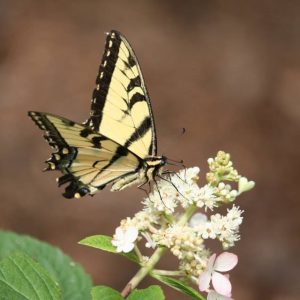

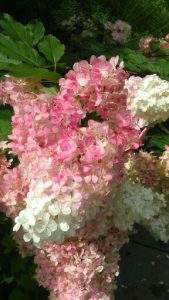

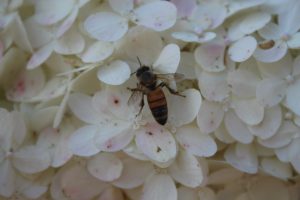 Description
Description
A Proven Winner selection, with prominant summer flowers.
Very attractive to bees, especially bumble bees.
Adaptable to most soils, and flower color is not affected by soil pH.
Grow for cut and dried flowers
Flower Color: Large white flowers that can turn pink.
Zones: 3 to 8
Growth Habit: Medium
Height: 4 to 5′
Spread: 4 to 5 ‘
Light Needs: Sun to partial shade
Flowering Season: Summer
Landscape Value: 5 of 5
Naturalizing Value: n/a
Pollen Value: 3 of 5
Nectar Value: 3 of 5
Water Requirements: Medium
Native: Japan, China
Invasive: No
Seven Son Flower (Heptacodium miconiodes)
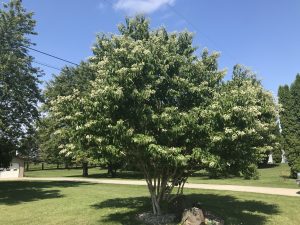

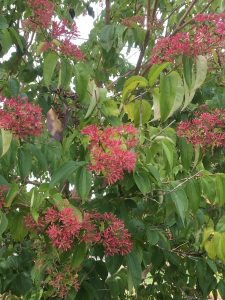

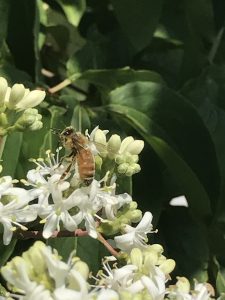
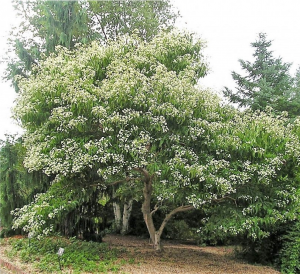
Description
This unique small tree was discovered in China in 1907, with only 9 small populations and may now be extinct in it’s native range. It’s seeds were collected and it was introduced to the United States from China in 1980. This September-flowering tree is starting to gain followers in the US as a 4-season landscape tree with great pollinator interest. It has attractive exfoliating bark in the winter, white late-summer flowers, with a 2-3 week bloom period, followed by pink-red seeds, ‘Seven Sons’ refers to a single flower in a six-flowered whorl. Plant it as an ornamental tree and you will not be disappointed. After the flowers are done the calyx, or floral envelope, turns bright red and remain on the tree into November.
Flower Color: White
Zones: 4-8
Growth Habit: Shrub/small tree
Height: 15-20′
Spread: 10-15′
Light Needs: Sun/shade
Flowering Season: Late Summer
Landscape Value: 5 of 5
Naturalizing Value: n/a
Pollen Value: 3 of 5
Nectar Value: 3 of 5
Water Requirements: Acidic, well-drained, moist soil.
Native: China. Probably extinct in its native range.
Invasive: No
Seven Sons cultivar "Temple Of Bloom" (Heptacodium miconioides)



Description
Hang on to your hat – Temple of Bloom® seven-son flower is going to blow your mind!We are thrilled to be able to bring this outstanding plant, previously known only by collectors and plant geeks, to everyone in North America. Temple of Bloom seven-son flower is a beautiful, easy to grow small tree which simply can’t be matched for year-round beauty. In spring, the handsome leaves emerge, each sporting dramatically deep veins that make the plant stand out in the landscape. As the season progresses, the leaves grow larger and develop a long, twisting tip. Come August, when everything else is winding down, Temple of Bloom seven-son flower is just coming into its own, as it becomes covered in big clusters of fragrant white flowers that hummingbirds and other pollinators flock to. They last for weeks before gracefully falling to the ground to reveal vivid red, fan-like bracts, which make it look like the plant is blooming again in a completely different color. As winter comes and the leaves drop, the plant’s elegant frame is revealed, along with amazing light tan peeling bark.Temple of Bloom® seven-son flower is the perfect choice for a special spot in your landscape. Plant it where it can be seen, often, and enjoyed any time of the year. Available in better garden centers in spring 2019. Top reasons to grow Temple of Bloom® seven-son flower:- Contribute outstanding interest to your home but needs little care.- Flowers in late summer and fall, when other plants are winding down.- Peeling bark looks great year-round but is especially memorable in winter.If you can’t tell, we’re more than a little excited about Temple of Bloom® seven-son flower!
Long Blooming
Fall Interest
Winter Interest
Heat Tolerant
Attracts:
Bees
Butterflies
Hummingbirds
Sumac - Staghorn (Rhus typhina)
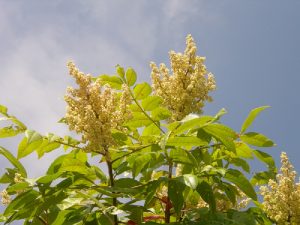
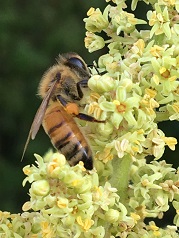


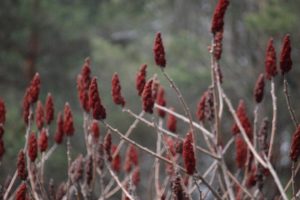
Description
A large, loose spreading shrub that grows in poor soil and often seeds itself
on banks and road cuts.
Sometimes used as a street tree because of it’s tolerance to abuse.
Naturally forms colonies. Great honey plant. The seeds are used as smoker fuel.
Flower Color: Greenish -yellow
Zones: 4-8
Growth Habit: Colonies
Height: 10-15′
Spread: 10-15′
Light Needs: Sun
Flowering Season: June
Landscape Value: 1 of 5
Naturalizing Value: 3 of 5
Pollen Value: 2 of 5
Nectar Value: 4 of 5
Water Requirements: low
Native: Yes
Invasive: No
Willow, Pussy - Goat Willow (Salix caprea)
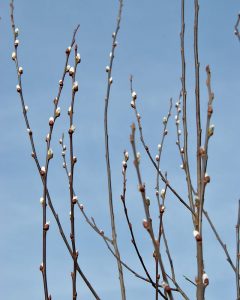
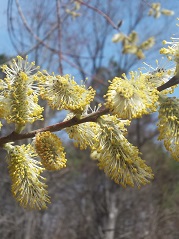

Description
If you only have room for one small tree in you landscape, plant this one!
The silky catkins appear in March and are readily visited by hungry bees.
Both male and female flowers produce nectar; the male gives pollen only.
Likes wet feet, but will grow upland as well.
Flower Color: Yellow
Zones: 4-7
Growth Habit: shrub
Height: 15′
Spread: 10′
Light Needs: Sun to part shade
Flowering Season: Early Spring
Landscape Value: 5 of 5
Naturalizing Value: 5 of 5
Pollen Value: 4 of 5
Nectar Value: 2 of 5
Water Requirements: moist to wet
Native: Europe
Invasive: No
Caryopteris Bluebeard (Caryopteris x clandonensis) P
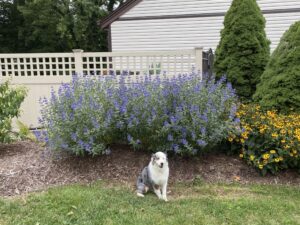
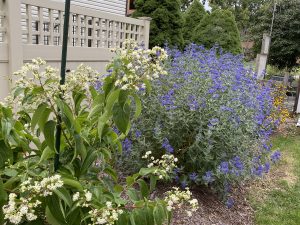
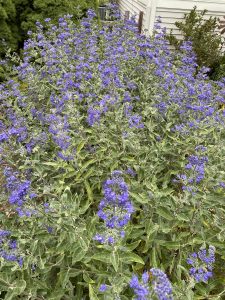
Description
Dark and dreamy!
You’ll love this new caryopteris – it has extremely dark, glossy foliage, a compact habit, and deep blue flowers. It adds much-needed color to the late summer landscape and makes a handsome companion with perennials. A great favorite with pollinators of all types!
Top three reasons to grow Beyond Midnight® caryopteris:
- Adds fresh color to the landscape late in the season
- Attracts bees, butterflies, and hummingbirds
- Better color and habit than other caryopteris
Ninebark "Summer Wine" (Physocarpus opulifolius) Proven Winner Selection

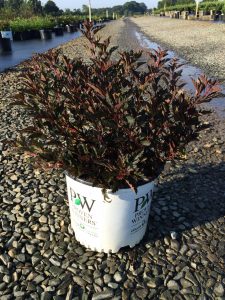
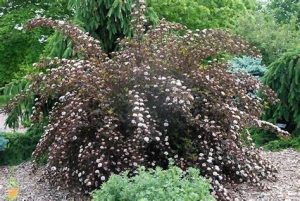
Description
Easy, durable summer color! An exciting improvement to Ninebark, Summer Wine combines the fine texture and compact branching of Physocarpus ‘Nana’ with the dark foliage of Physocarpus Diabolo. Summer Wine is an easy way to introduce wine-colored foliage into the home garden. It is fast-growing and has few, if any, pest problems. Its graceful, arching habit makes it very appealing in the landscape. It adds beautiful color and vibrancy to your garden, especially in spring. In early June it blooms with white button-like flowers that accent the leaves nicely. Pruning and other maintenance is rarely needed. Use it as a bold accent or part of a mixed border. Summer Wine may even be cut for use in arrangements. This is a trouble-free addition to either the home or commercial landscape.
Best Seller
Fall Interest
Drought Tolerant
Native to North America
Mock Orange "Illuminati Tower" (Philadelphus coronarius)

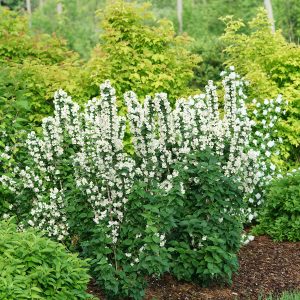

Description
Reach a higher plane in your landscape or garden.Mockorange is a delightfully old-fashioned plant that has unfortunately fallen out of favor, mostly due to its enormous size. Illuminati Tower® mockorange stands to breathe new life into this classic favorite, though, combining a landscape-friendly size with a totally unique space-saving habit. It naturally grows in a very narrow, upright way, each sturdy stem a stack of rugged, deep green leaves that looks like a four-sided tower. In late spring/early summer, hundreds of fragrant white flowers emerge from between the leaves for striking show that truly celebrates the season. Top reasons to grow Illuminati Tower mockorange:- never-before-seen space-saving habit takes up a fraction of the room of older varieties- very fragrant white flowers in late spring/early summer have a sweet fragrance that carries on the warm breezes- Deer resistant and drought tolerant
Fragrant Flower
Drought Tolerant
Itea "Little Henry" (Itea virginica)
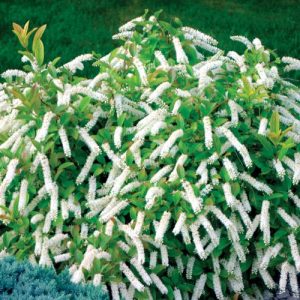
Description
As colorful as burning bush, but native to North America and pollinator friendly!Little Henry is a useful native plant with lots of potential for the home landscape. It prefers moist soils and will tolerate wet conditions. It will grow in full sun to full shade, and requires little pruning or other maintenance. Little Henry has lightly scented, pure white flowers that shoot like fireworks in the early summer horizon. Its mounded, compact stature makes it an improvement over older varieties such as the old favorite ‘Henry’s Garnet’. It is also a delightful addition to the mixed border. Then when you’re not expecting anything more, green summer foliage changes to a brilliant multitude of oranges and reds in the fall, making Little Henry a rewarding experience through out all seasons.
Fragrant Flower
Fall Interest
Drought Tolerant
Erosion Control
Bog Plant
Attracts:
Bees
Butterflies
Resists:
Deer
Native to North America

